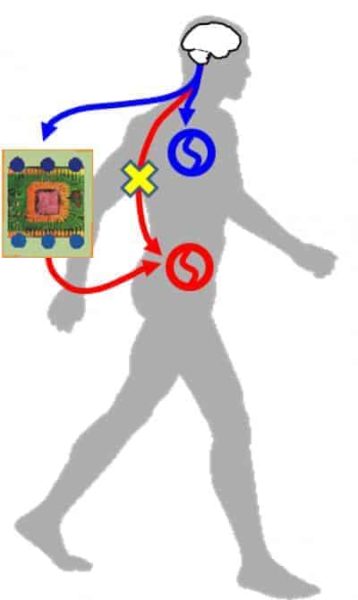Gait disturbance in individuals with spinal cord injury is attributed to the interruption of neural pathways from brain to the spinal locomotor center, whereas neural circuits locate below and above the lesion maintain most of their functions. An artificial connection that bridges the lost pathway and connects brain to spinal circuits has potential to ameliorate the functional loss. A Japanese research group led by Shusaku Sasada, research fellow and Yukio Nishimura, associate professor of the National Institute for Physiological Sciences (NIPS), National Institutes of Natural Sciences (NINS) has successfully made an artificial connection from the brain to the locomotion center in the spinal cord by bypassing with a computer interface. This allowed subjects to stimulate the spinal locomotion center using volitionally-controlled muscle activity and to control walking in legs. This result was published online in The Journal of Neuroscience on August 13, 2014.
Neural networks in the spinal cord, locomotion center are capable of producing rhythmic movements, such as swimming and walking, even when isolated from the brain. The brain controls spinal locomotion center by sending command to the spinal locomotion center to start, stop and change waking speed. In most cases of spinal cord injury, the loss of this link from the brain to the locomotion center causes problems with walking.
The research group came up with bypassing the functioning brain and locomotion center with the computer to compensate lost pathways as a way to enable individuals with spinal cord injury to regain walking ability.
Since the arm movement associte with leg movement when we walk they used muscle activity of arm to sarogate the brain activity. The computer interface allowed subjects to control magnetic stimulator that drive to the spinal locomotion center non-invassively using volitionally-controlled muscle activity and to control walking in legs. As a results of experiments in people who are neurologically intact, the subjects were asked to make own legs relaxed and passively controlled via computer interface that was controlled by arm muscle, walking behavior in legs was induced and subjects could control the step cycle volitionally as well. However without bypassing with the computer interface, the legs did not move even if the arms muscle was volitionally acivated.
“We hope that this technology would compensate for the interrupted pathways’ function by sending an intentionally encoded command to the preserved spinal locomotor center and regain volitionally-controlled walking in indviduals with paraplegia. However, the major challenge that this technology does not help them to dodge obstacles and to maintain posture. We are carefully working toward clinical application in near future”, Nishimura said.



Someone needs to proofread this!